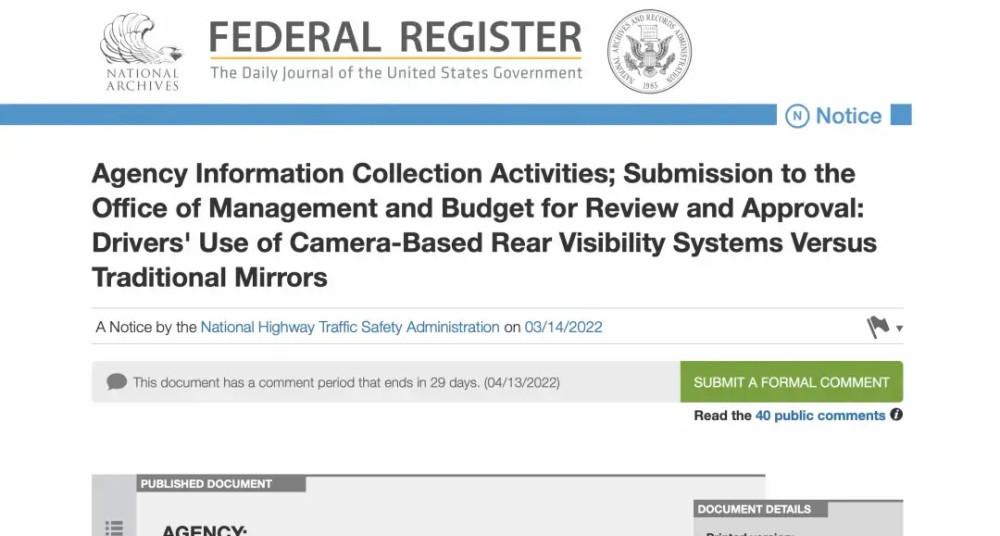As early as 2014, Tesla had joined hands with Toyota, Volkswagen, General Motors and other automakers to submit a proposal to NHTSA (U.S. Highway Safety Administration), proposing to replace the traditional car rearview mirror with a rearview camera, and full electronicization has become a trend in the development of automobiles.

But after so many years, the proposal has been delayed in its adoption. In recent days, however, the National Highway Traffic Safety Administration (NHTSA) and the Department of Transportation (DOT) have issued a Federal Gazette notice and a public call for comment on whether a camera can replace a rearview mirror.
The proposal is now in its final stages and will be submitted to the U.S. Office of Public and Budget Management (OMB) for review and approval.
What are the advantages?
The volume of the camera will be smaller than that of the traditional rearview mirror, first, it is easy to pass through the narrow road, avoiding unnecessary scratching; second, it is conducive to reducing wind resistance, thereby providing better economy.
The unavoidable blind spot of the traditional rearview mirror will produce accident hazards. The camera can automatically adjust the angle and direction, which is more flexible when transmitting the outside picture, and the wide-angle lens has a wider line of sight.
When driving in rain, the rearview mirror and the glass on both sides are shrouded in water mist, which often allows the owner to see the outside of the car, and the camera can alleviate such a situation to a certain extent.
Trend
In the impression of Jianghujun, when the Audi e-tron concept car was unveiled, it replaced the traditional reversing mirror with a camera. The official test results show that after using a lighter camera, the vehicle's wind resistance coefficient was reduced from the original 0.28 to 0.27, increasing the cruising range of 6.4km.
It can be seen that when the wind resistance of the car is reduced, it can also play an energy-saving effect. In today's increasingly "take-off" of oil prices, the camera replaces the rearview mirror and is more expected.
At present, countries that have clearly stipulated the abolition of traditional reversing mirrors include India and Japan. India was forced to cancel the reversing mirrors in order to avoid scratching because of the large number of people, cars and narrow roads.
Japan has also legislated to eliminate reversing mirrors, allowing cars to replace traditional reversing mirrors with cameras, and the earliest to taste was the Lexus ES, which helped owners see the road behind them through two cameras and two 5-inch screens designed in the A-pillar
Maturity is to be considered
New technologies are maturing, often constantly improving in practice. For example, in the case of snow in winter, many hidden door handles will freeze, resulting in the failure to open the door. The camera rearview mirror will also encounter such problems, after all, whether it can still operate stably in extreme weather also needs to be considered by manufacturers.
Although there are some drawbacks to traditional rearview mirrors, they are expensive in terms of low failure rate. The camera working environment on both sides of the car is complex, and the imaging requirements are extremely high, and it is difficult to ensure stable work.
In addition, the issue of cost is crucial. Not only two cameras, but also two screens, linked wiring harnesses, and chips that handle ISPs and imaging, which are much more expensive than traditional rearview mirrors. And in our daily driving, as long as there is a side scratch, the rearview mirror is the "direct victim". If the camera is replaced or repaired, it is difficult to guarantee the use of the original factory.
The previous few days, the United States canceled the steering wheel regulations is also this process, so it is only a matter of time before the camera is replaced by a rearview mirror. That is to say, if the manufacturer overcomes the technical problems, the camera rearview mirror will become the "general trend". So if one day the country allows this technology, will you use it? Welcome to leave a message in the comment area, and discuss with everyone.